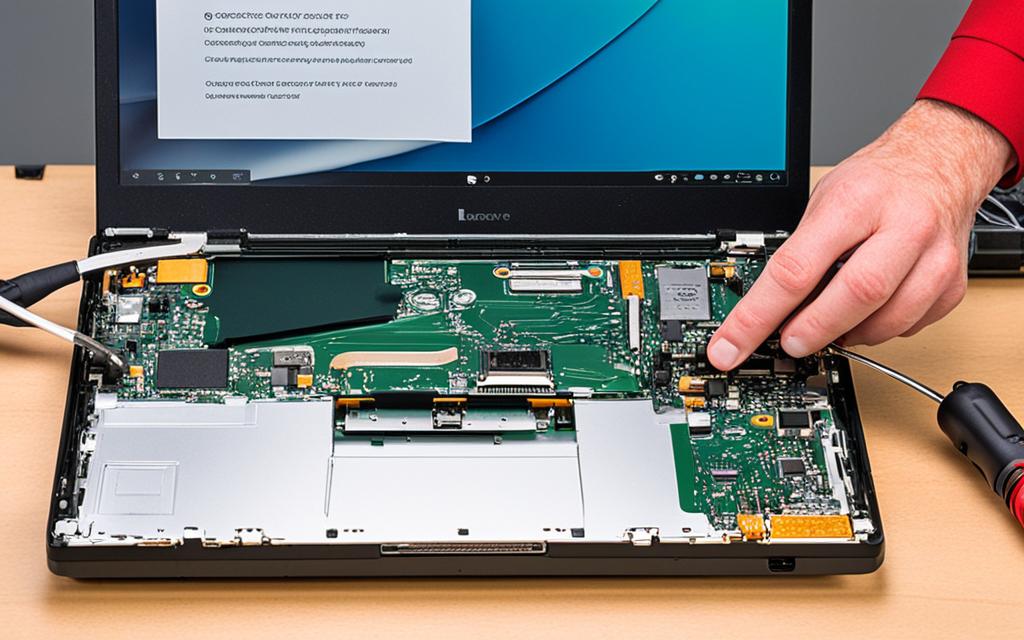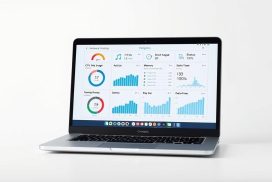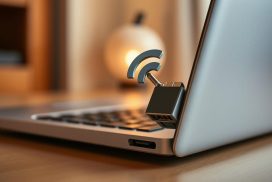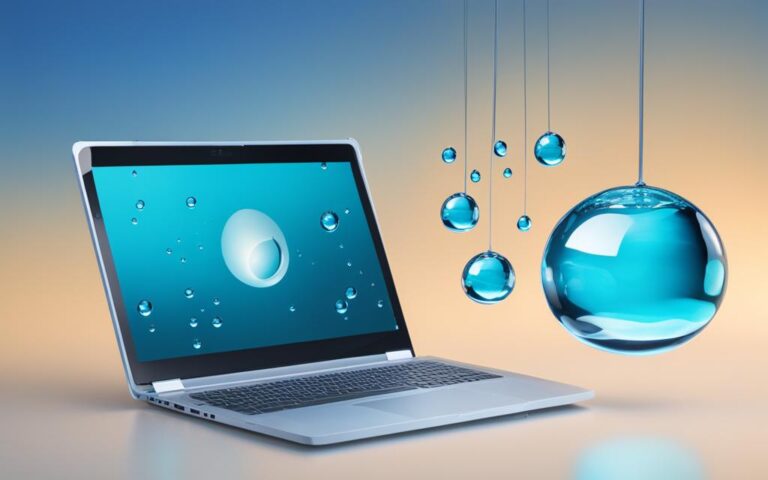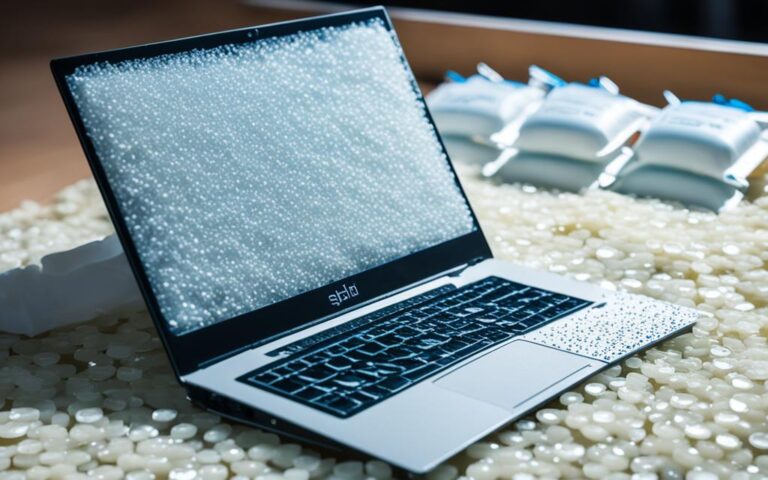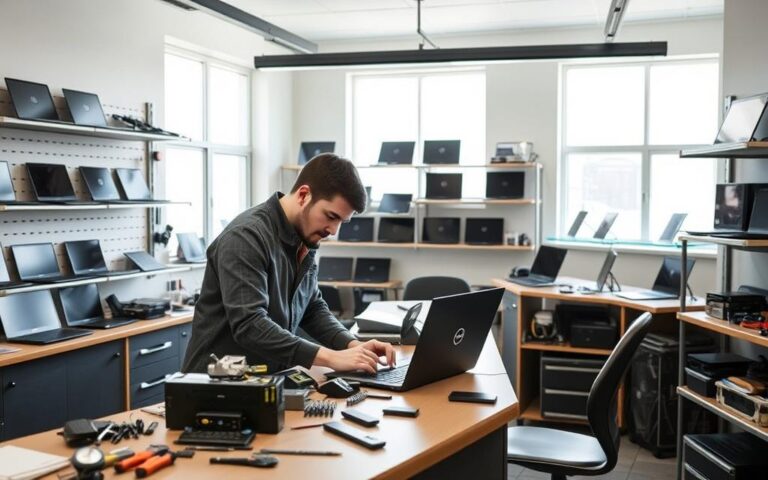DIY Tips for Repairing Laptop Charging Ports
A broken laptop charging port can be a serious issue that can disrupt your device’s functionality. In this guide, we will provide you with DIY tips on how to repair laptop charging ports. We will also discuss common causes of charging port damage and essential tools you will need for the repair process.
When your laptop charging port stops working, it can be frustrating and inconvenient. However, with the right knowledge and tools, you can fix it yourself and save money on professional repairs.
Our step-by-step guide will walk you through the process of repairing your laptop charging port. From understanding the causes of charging port damage to performing the repair yourself, we’ve got you covered.
Whether you’re experiencing a loose connection, water damage, or general wear and tear, our DIY tips will help you get your laptop back up and running in no time.
Stay tuned for our detailed instructions on cleaning the charging port, accessing the port, and replacing it with a new one. We’ll also provide helpful tips on preventing future charging port damage.
Don’t let a broken laptop charging port slow you down. With our DIY tips, you’ll be able to fix it yourself and get back to using your laptop without any disruptions.
Keep reading to learn more about DIY laptop charging port repair and become a pro at fixing your own devices.
Understanding the Causes of Laptop Charging Port Damage
When your laptop charging port stops working, it can be frustrating and inconvenient. There are several reasons why this issue may occur, and understanding the causes can help you prevent further damage and determine the necessary repairs. Let’s explore the common culprits behind laptop charging port damage:
1. Water Damage
Accidental spills or exposure to moisture can cause significant harm to the charging port. The contact between water and electrical components can lead to short circuits, corrosion, and irreversible damage. It is crucial to keep liquids away from your laptop and avoid charging it in damp environments.
2. Dust and Debris Accumulation
Over time, dust, dirt, and debris can accumulate in the charging port, obstructing the connection between the charger and the power socket. This build-up can prevent a secure connection, render the charging port ineffective, and potentially damage internal components. Regular cleaning and maintenance can help prevent this issue.
3. Wear and Tear from Regular Use
Repeated plugging and unplugging of the charger can cause wear and tear on the charging port. The constant movement can loosen connections, strain the port’s structure, and result in a faulty connection. To minimize this type of damage, handle the charger and port with care and avoid unnecessary bending or tugging.
4. Loose Connections
A loose or damaged charging cable can also contribute to charging port issues. Bent or frayed cables may not make proper contact with the port, leading to intermittent charging or a complete failure to charge. It is essential to regularly inspect your charger cable and replace it if necessary to avoid potential damage to the charging port.
5. Improper Charging Practices
Using incompatible chargers or overloading the charging port with excessive power demands can strain the components and lead to damage. It is crucial to use only the manufacturer-recommended charger and avoid using third-party chargers that may not meet the necessary specifications. Furthermore, refrain from charging multiple devices simultaneously through the laptop’s USB ports to prevent overloading.
By understanding the causes of laptop charging port damage, you can take appropriate precautions to ensure the longevity of your device. Regular maintenance, proper handling of cables, and adhering to manufacturer guidelines for charging can help prevent issues and extend the lifespan of your laptop’s charging port.
Stay tuned for the next section where we will discuss the essential tools you will need to repair a laptop charging port.
| Cause | Description |
|---|---|
| Water Damage | Accidental spills or moisture exposure |
| Dust and Debris Accumulation | Build-up of dust, dirt, and debris in the port |
| Wear and Tear from Regular Use | Damage from repeated plugging and unplugging of the charger |
| Loose Connections | Issues caused by loose or damaged charging cable |
| Improper Charging Practices | Using incompatible chargers or overloading the port |
Essential Tools for Laptop Charging Port Repair
Performing a laptop charging port repair requires specific tools. Having these essential tools on hand will help facilitate the repair process and ensure a successful outcome.
1. Screwdriver
A screwdriver is necessary for removing screws that secure the laptop’s back cover and access the charging port. It is important to use the correct screwdriver size to avoid damaging the screws.
2. Soldering Gun
A soldering gun is essential for desoldering the old charging port and soldering the replacement port in place. It allows for precise and secure connections, ensuring the charging port functions properly.
3. Compressed Air
Using compressed air helps clean the charging port of any dust, debris, or dirt that may be hindering the connection. It is important to gently blow air into the port to avoid any damage.
4. Toothbrush
A toothbrush with soft bristles is ideal for thorough cleaning of the charging port. It can easily remove stubborn dirt and residue that compressed air may not dislodge.
5. Extra Charger
Having an extra charger on hand allows for testing the repaired charging port once the repair is complete. It ensures that the port is functioning correctly and can properly charge the laptop.
6. Additional Screws
Having a few extra screws of the appropriate size is useful in case any screws are misplaced or damaged during the repair process. It ensures that the laptop’s back cover can be securely reattached.
Remember, using the correct tools and following proper repair procedures is essential to avoid further damage to your laptop’s charging port. If you’re unsure about any step of the repair process, it’s always best to consult a professional for assistance.
Step-by-Step Guide to DIY Laptop Charging Port Repair
Repairing a laptop charging port can be a daunting task, but with the right instructions, it can be done successfully. Follow this step-by-step guide for a DIY laptop charging port repair:
- Step 1: Check the charger cable
Before proceeding with any repairs, try using a different charger cable to ensure that the cable itself is not the issue. If the laptop charges properly with a different cable, then the problem lies with the original cable. - Step 2: Clean the charging port
If the charger cable is not the problem, the next step is to clean the charging port. Start by removing any debris or dust that may have accumulated inside the port. You can use compressed air to blow away the particles and a toothbrush to gently scrub the port, ensuring it is clean and free from any obstructions. - Step 3: Open the device and access the charging port
If cleaning the charging port doesn’t resolve the issue, you may need to open the laptop and access the charging port. Begin by removing the back cover of the laptop. Make sure to keep track of the screws and their placements to avoid confusion during reassembly. - Step 4: Inspect the wires and connections
Once the back cover is removed, carefully inspect the wires and connections leading to the charging port. Look for any signs of damage or loose connections. If you find any loose wires, reattach them securely. If there is visible damage, you may need to replace the damaged wires or consult a professional for further assistance. - Step 5: Remove the old charging port
To replace the charging port, you will need a soldering gun. Heat up the soldering gun and carefully desolder the old port from the laptop’s circuit board. Take your time and ensure that all the connections are properly detached before removing the old port. - Step 6: Replace the charging port and reassemble the laptop
Once the old charging port is removed, you can replace it with a new one. Align the new port with the correct pins on the circuit board and solder it into place. Afterward, carefully reassemble the laptop, making sure to secure all the screws and connections.
By following these step-by-step instructions, you can attempt a DIY laptop charging port repair. However, if you are uncomfortable with any step or encounter any difficulties, it is always advisable to seek professional assistance to avoid causing further damage to your device.
Note: The above image illustrates the step-by-step process of repairing a laptop charging port.
Tips for Avoiding Laptop Charging Port Damage
To ensure the longevity of your laptop charging port and minimize the need for repairs, it’s important to take proactive steps in its maintenance. Follow these expert tips to prevent laptop charging port damage:
- Avoid using your laptop while charging: Although it’s tempting to multitask, using your laptop while it’s connected to the charger can put strain on the charging port and increase the risk of damage. To prevent this, try to use your laptop on battery power whenever possible.
- Use a compatible charger: Always use a charger that is specifically designed for your laptop model. Using a charger that is not compatible can result in irregular power supply and lead to charging port issues.
- Insert and remove the charger carefully: Handle your charger with care when inserting and removing it from the charging port. Avoid applying excessive force or twisting motions, as this can cause stress on the port and lead to damage.
- Keep the charging port clean: Regularly clean the charging port to prevent dust and debris accumulation. Use a soft brush or compressed air to remove any particles that may obstruct proper charging.
- Avoid excessive bending or twisting of the charger cable: Tension on the charger cable can strain the charging port and weaken its connections over time. Make sure to handle the cable gently and avoid bending or twisting it excessively.
By following these tips, you can keep your laptop charging port in optimal condition and extend its lifespan, reducing the risk of damage and the need for costly repairs.
Laptop Charging Port Maintenance Tips
In addition to the above tips, it’s essential to maintain your laptop charging port regularly. Here are a few maintenance practices to consider:
- Inspect the charging port: Periodically check the condition of the charging port for any physical damage, loose connections, or bent pins. If you notice any issues, consult a professional technician for further assistance.
- Use protective port covers: Consider using port covers or dust plugs to shield the charging port from dirt, dust, and moisture when it’s not in use. This can help prevent potential damage caused by external elements.
- Avoid harsh environments: Do not expose your laptop to extreme temperatures, humidity, or liquids, as these factors can negatively affect the charging port and other internal components.
- Regularly update your laptop’s firmware: Keeping your laptop’s firmware up to date can optimize charging efficiency and ensure compatibility with the latest charging technologies.
By incorporating these maintenance tips into your routine, you can safeguard your laptop’s charging port and enjoy uninterrupted charging for years to come.
Comparison of Laptop Charging Port Types
| Laptop Charging Port Types | Advantages | Disadvantages |
|---|---|---|
| USB-C | Fast charging, universal compatibility, reversible connector | Adapter may be required for older devices |
| MagSafe | Magnetic connection for easy attachment and detachment, helps prevent accidental tripping | Obsolete on newer MacBook models |
| Proprietary | Customized charger design for optimal performance | Limited availability and compatibility, potential for higher replacement costs |
Benefits of Wireless Charging as an Alternative
If your laptop charging port is beyond repair or you prefer a hassle-free charging experience, wireless charging can be an ideal alternative. With wireless chargers, you can conveniently power up your laptop without the need for physical charger ports. This innovative technology utilizes electromagnetic induction, allowing you to charge your laptop by simply placing it on an induction pad.
Wireless charging offers several advantages over traditional charging methods. Firstly, it eliminates the hassle of dealing with tangled charging cables and worn-out charger ports. You no longer need to worry about damaging or replacing your laptop’s charging port.
Additionally, wireless charging provides faster and more efficient charging speeds, ensuring that your laptop is ready to go in no time. You can conveniently charge your laptop while working, without the limitations of a wired connection.
Wireless charging for laptops introduces a new level of convenience and flexibility in today’s fast-paced world. It allows users to effortlessly power up their laptops and stay productive without the limitations of physical charging ports. Embrace the freedom and efficiency of wireless laptop charging for a seamless charging experience.
To give you a better understanding of the advantages of wireless laptop charging, here is a table comparing wireless charging with traditional wired charging:
| Advantages of Wireless Charging | Advantages of Traditional Wired Charging |
|---|---|
| Eliminates the need for physical charging ports | Requires a physical charging port and cable |
| Reduces wear and tear on charger ports | Charger ports may wear out over time |
| Provides faster charging speeds | Charging speeds may vary |
| Enables greater flexibility and mobility | Limited by cable length and connection |
As you can see, wireless charging offers significant advantages, making it a compelling option for laptop users seeking a convenient and efficient charging solution. Embrace the future of laptop charging with wireless technology.
The Importance of Professional Help for Complex Repairs
While DIY repairs can be cost-effective for simple charging port issues, it’s essential to recognize that some repairs require the expertise of a professional laptop repair shop. When faced with complex charging port problems, seeking professional help is the wisest choice to ensure a successful and safe resolution.
If you are uncomfortable with soldering or encounter difficulties accessing the charging port, it’s time to enlist the services of a professional. Professional laptop repair technicians possess the necessary knowledge and tools to handle intricate repairs effectively. They are equipped to address various charging port issues, providing expert solutions for optimal safety and functionality.
Attempting complex repairs without the right expertise can lead to further damage, exacerbating the problem and potentially rendering your laptop unusable. With a professional laptop repair shop, you can trust that the repair process will be meticulous, safeguarding your device from any unnecessary risks or complications.
Moreover, professional laptop repair shops often offer warranty and guarantee on their services, providing you with peace of mind in case any issues arise after the repair. Their expertise and experience ensure that the repair is performed efficiently, minimizing the chances of recurring issues or future damages.
“When faced with complex charging port issues, seeking professional help is the wisest choice to ensure a successful and safe resolution.”
In summary, professional help is crucial when dealing with complex charging port repairs. By entrusting the repair process to skilled technicians, you can avoid potential risks, ensure the longevity and functionality of your laptop, and have the peace of mind that your device is in capable hands.
Conclusion
Repairing a laptop charging port can be a challenging task, but with the right tools and know-how, you can successfully fix it yourself. Proper maintenance and preventive measures can also help avoid future charging port damage. By following simple steps like avoiding excessive bending of the charger cable and keeping the port clean from dust and debris, you can extend the lifespan of your laptop charging port.
However, if you encounter complex issues or feel unsure about the repair process, it is advisable to seek professional help. Consulting a reputable laptop repair service ensures that intricate repairs are carried out safely and effectively, preserving the functionality of your device. These professionals possess the required expertise and tools needed for more complicated charging port repairs.
Remember to always handle your laptop with care and prioritize safety when performing any repairs. Maintaining a well-functioning charging port is essential for uninterrupted device usage, so it is worth investing time and effort in its maintenance and seeking professional assistance when needed.
FAQ
What are some common causes of laptop charging port damage?
Common causes of laptop charging port damage include water damage, dust and debris accumulation, wear and tear, loose connections, and improper charging practices.
What tools will I need for laptop charging port repair?
The essential tools for laptop charging port repair include a screwdriver, soldering gun, compressed air, toothbrush, extra charger, and additional screws.
How do I repair a laptop charging port?
To repair a laptop charging port, you can try a different charger cable, clean the port, and if necessary, open the device, check the connections, remove the old port with a soldering gun, and replace it.
What preventive measures can I take to avoid laptop charging port damage?
You can prevent laptop charging port damage by avoiding using your laptop while charging, using a compatible charger, inserting and removing the charger carefully, keeping the port clean, and avoiding excessive bending or twisting of the charger cable.
What are the benefits of wireless charging as an alternative?
Wireless charging eliminates the need for physical charger ports and offers faster charging speeds. It provides a hassle-free charging experience.
When should I seek professional help for laptop charging port repair?
If you are uncomfortable with soldering or have difficulty accessing the charging port, it is best to seek professional help. They have the expertise and tools to perform intricate repairs and ensure the safety and functionality of your laptop.
Is it possible to repair a laptop charging port myself?
Yes, with the right tools and know-how, you can successfully repair a laptop charging port yourself. However, for complex repairs or if you are unsure about the process, it is advisable to consult a professional laptop repair service.
What is the importance of proper maintenance and preventive measures for laptop charging ports?
Proper maintenance and preventive measures can help prolong the lifespan of your laptop charging port and minimize the need for repairs. It is important to handle your laptop with care and prioritize safety when performing any repairs.
